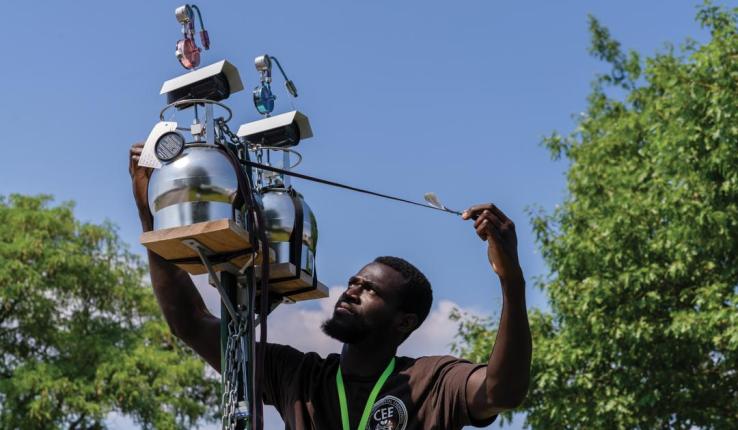Nature Reveals a New Shape: the Scutoid
Javier Buceta and a team of international researchers reveal a new geometric shape used by nature to pack cells efficiently.
Photo: Stephanie Veto
Move over triangle, circle, square and rectangle: There’s a new shape in town.
Javier Buceta, associate professor of bioengineering and chemical and biomolecular engineering, and his collaborators from Spain have uncovered a previously unknown geometric shape, which is adopted by packed epithelial cells during embryonic development.
They call it the scutoid.
The scutoid resembles a twisted prism, or, as Buceta described it to The New Yorker, “a prism with a zipper.” And even though it was previously unknown, the shape is found all over living things.
On major news outlets, social media and late-night television, the scutoid became a worldwide sensation this past summer. Stephen Colbert described it in an early-August monologue as the “hot new shape that’s burnin’ up the Internet.” It got its own limerick on NPR’s “Wait, Wait, Don’t Tell Me.” The shape was featured in The New York Times, Newsweek, Popular Science, Smithsonian and Forbes, among other news outlets, and Twitter was abuzz with news of its existence.
Even more importantly, however, the discovery could pave the way to understanding the three-dimensional organization of epithelial organs and lead to advancements in tissue engineering.
As an embryo develops, tissues bend into complex three-dimensional shapes that lead to organs. Epithelial cells are the building blocks of this process, forming, for example, the outer layer of skin. They also line the blood vessels and organs of all animals.
These cells pack together tightly. To accommodate the curving that occurs during embryonic development, it has been assumed that epithelial cells adopt either columnar or bottle-like shapes.
“Studies about epithelial cells have focused mostly on one side [surface] of these cells, in part due to technical limitations, and extrapolated that surface as a proxy for their three-dimensional structure,” Buceta told Newsweek in July.
Buceta and his colleagues dug deeper into this phenomenon and discovered that, during tissue bending, epithelial cells adopt a previously undescribed shape that enables the cells to minimize energy use and maximize packing stability. They first made the discovery through computational modeling that utilized Voronoi diagramming, a tool used in a number of fields to understand geometrical organization.
“During the modeling process, the results we saw were weird,” says Buceta. “Our model predicted that as the curvature of the tissue increases, columns and bottle-shapes were not the only shapes that cells developed. To our surprise, the additional shape didn’t even have a name in math! One does not normally have the opportunity to name a new shape.”
The group named the new shape the “scutoid” for its resemblance to the scutellum—the posterior part of an insect thorax or midsection.
To verify the model’s predictions, the group investigated the three-dimensional packing of different tissues in different animals. The experimental data confirmed that epithelial cells adopted shapes and three-dimensional packing motifs similar to the ones predicted by the computational model.
Using biophysical approaches, the team argues that the scutoids stabilize the three-dimensional packing and make it energetically efficient. As Buceta puts it: “We have unlocked nature’s solution to achieving efficient epithelial bending.”
The team’s results were published in Nature Communications in a paper called “Scutoids are a geometrical solution to three-dimensional packing of epithelia.”
The study is the result of a collaboration between the teams of Buceta and Luis M. Escudero of Seville University in Spain. Pedro Gomez-Galvez and Pablo Vicente-Munuera are the first authors of this work, which also includes scientists from the Andalucian Center of Developmental Biology and the Severo Ochoa Center of Molecular Biology, among others.
“In addition to this fundamental aspect of morphogenesis,” the group writes, “the ability to engineer tissues and organs in the future critically relies on the ability to understand, and then control, the 3D organization of cells.”
Adds Buceta: “For example, if you are looking to grow artificial organs, this discovery could help you build a scaffold to encourage this kind of cell packing, accurately mimicking nature’s way to efficiently develop tissues.”
The journal Nature published an article written by Guy Blanchard, a senior research associate in the department of physiology, development and neuroscience at the University of Cambridge, that highlighted the importance of the discovery. Blanchard writes that with the team’s work to characterize the scutoid “... we are beginning to recognize the kinds of 3D shapes and arrangements to look for in epithelia, and to develop tools for quantifying them.”
He asks: “Where else in nature should we expect scutoids? I would not bet against scutoids being found in plants, given the diversity of plant architectures. ... We shall have to wait and see.”
Current Biology, a leading journal in the field, will also feature an article by a top researcher in morphogenesis about the work’s significance in a forthcoming issue.
Buceta’s team in the U.S. and Escudero’s team in Spain are planning further research on scutoids and cell packing and are currently working to formalize the discovery both mathematically and physically.
“We are also looking at various tissues of different organisms,” says Buceta. “We want to understand the differences in the ways that cells are packing and what’s driving these differences.”
As for the public’s interest in the discovery of this previously unnamed shape, Buceta says: “We never, ever thought that it would have this kind of impact. We knew the discovery was something important, and we believed this could be relevant to our colleagues. But we didn’t expect to have this kind of impact and interest in popular culture.”
Beyond its potential impact on tissue engineering, Buceta is excited about the group’s novel discovery of a new shape and what could be a lasting influence.
“In our line of work, you normally don’t have many opportunities to name something,” Buceta told The New Yorker. “Honestly, in the beginning, we couldn’t believe that nobody before us had named this shape. I mean, geometry has been around forever—the square, the circle. It’s really wonderful that we could name something this fundamental. Hopefully, that name is going to be there forever, and hopefully linked with our research.”
Kelly Hochbein contributed to this report.
Posted on:




